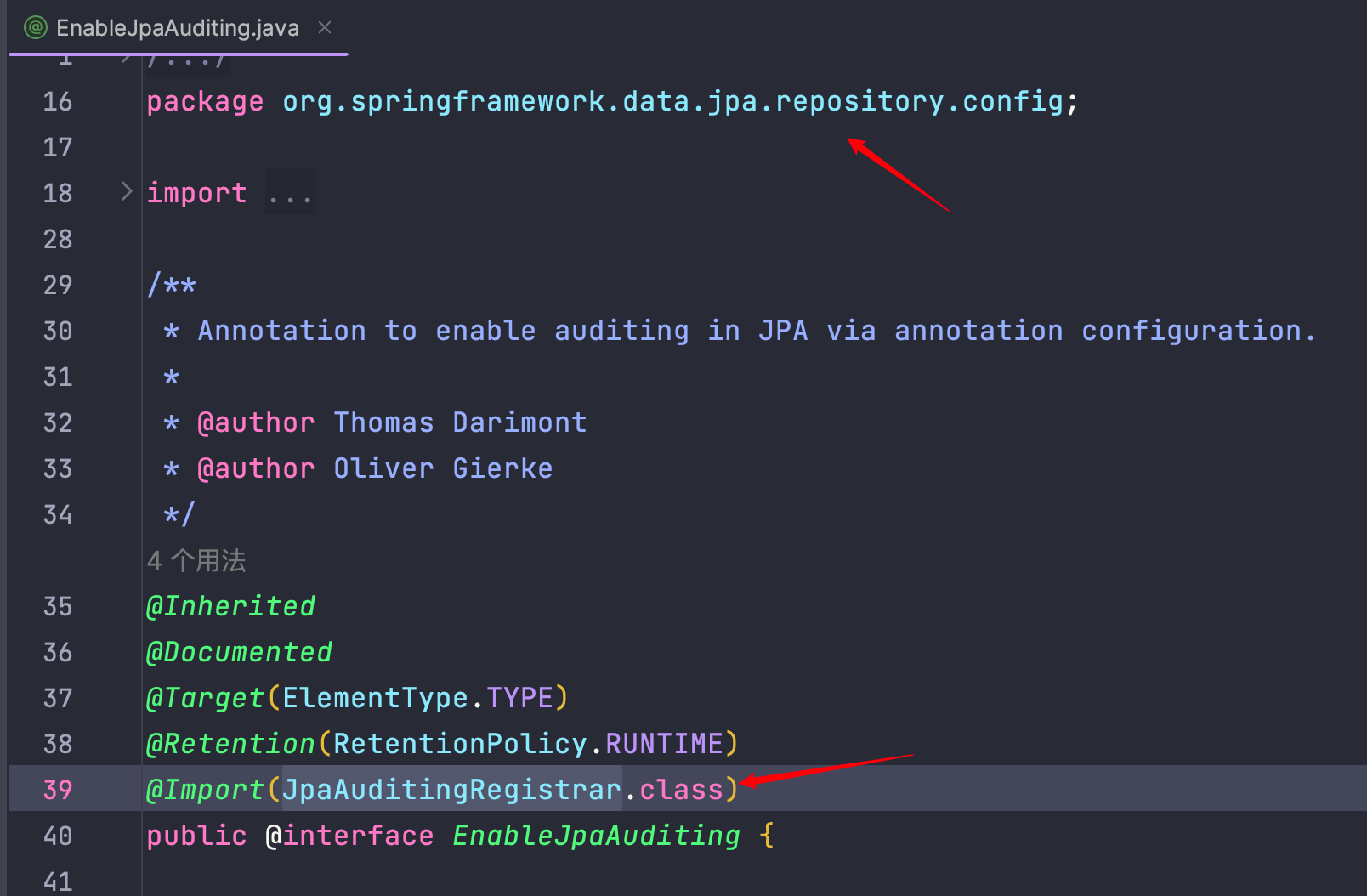一、开启jpa审计
EnableJpaAuditingConfig.java
二、在Entity对象添加对应属性和注解
在Entity对象添加对应属性
其中最主要的四个字段分别记录创建⼈、创建时间、最后修改⼈、最后修改时间。
还需要在Entity对象上天@EntityListeners
还需要在Entity对象上天@EntityListeners(AuditingEntityListener.class)
三、实现 AuditorAware 接⼝
实现 AuditorAware 接⼝,告诉 JPA 当前的⽤户是谁。
这⾥关键的⼀步,是实现 AuditorAware 接⼝的⽅法,如下所示:
这里其实可以通过SpringSecurityUtils.工具类来获取用户或者说获取用户ID。
我们需要开启 JPA 的 Auditing 功能(默认没开启)。这⾥需要⽤到的注解是 @EnableJpaAuditing,我们在第一步已经开启了。只有涉及到用户审计才需要编写AuditorAware<T>的实现类,这里可以配置下开启并把AuditorAware配置进来。代码如下:
四、在实体里面实现 Auditable 接口(第二种方式)
在 User 实体Entity对象,修改如下:
与第⼀种⽅式的差异是,这⾥我们要去掉上⾯说的四个注解,并且要实现接⼝ Auditable 的⽅法,代码会变得很冗余和啰唆。
⽽其他都不变,我们再跑⼀次刚才的测试⽤例,发现效果是⼀样的。从代码的复杂程度来看,这种⽅式我不推荐使⽤。那么我们再看⼀下第三种⽅式。
五、利用@MappedSuperclass 注解(第三种方式)
对象的多态的时候提到过这个注解,它主要是⽤来解决公共 BaseEntity 的问题,⽽且其代表的是继承它的每⼀个类都是⼀个独⽴的表。
我们先看⼀下 @MappedSuperclass 的语法
注解⾥⾯什么都没有,其实就是代表了抽象关系,即所有⼦类的公共字段⽽已。那么接下来我们看⼀下实例。
第⼀步:创建⼀个 BaseEntity,⾥⾯放⼀些实体的公共字段和注解。
注意: BaseEntity ⾥⾯需要⽤上⾯提到的四个注解,并且加上 @EntityListeners(AuditingEntityListener.class),这样所有的⼦类就不需要加了。
实际⼯作中,BaseEntity 可能还更复杂⼀点,⽐如说把 ID 和 @Version 加进去,会变成如下形式:
第⼆步:实体直接继承 BaseEntity 即可。
这样的话,User 实体就不需要关⼼太多,我们只关注⾃⼰需要的逻辑即可,如下:
去掉了 @EntityListeners(AuditingEntityListener.class);
去掉了 @CreatedBy、@CreatedDate、@LastModifiedBy、@LastModifiedDate 四个注解的公共字段。
接着我们再跑⼀下上⾯的测试⽤例,发现效果还是⼀样的。
六、Auditing 的实现原理
第⼀步:还是从 @EnableJpaAuditing ⼊⼿分析。
我们前⾯讲了它的使⽤⽅法,这次我们分析⼀下其加载原理,看下⾯的图:

通过包名可以知道,⾸先 Auditing 这套封装是 Spring Data JPA 实现的,⽽不是 Java Persistence API 规定的,其注解⾥⾯还有⼀项重要功能就是 @Import(JpaAuditingRegistrar.class) 这个类,它帮我们处理 Auditing 的逻辑。
我们看其源码,⼀步⼀步地 debug 下去可以发现如下所示:

进⼀步进⼊到如下⽅法中:

可以看到 Spring 容器给 AuditingEntityListener.class 注⼊了⼀个 AuditingHandler 的处理类。
第⼆步:打开 AuditingEntityListener.class 的源码分析 debug ⼀下。
从源码我们可以看到,AuditingEntityListener 的实现还是⽐较简单的,利⽤了 Java Persistence API ⾥⾯的@PrePersist、@PreUpdate 回调函数,在更新和创建之前通过 AuditingHandler 添加了⽤户信息和时间信息。
定义自定义监听器类
自定义监听器会用到以下几种注解,可以监听数据库操作的不同时机。
以下是CustomEntityAuditingListener类的实现代码,使用了@PrePersist和@PreUpdate两个注解。
使用的话,需要在Entity对象添加对应EntityListers注解包含自定义的监听类
老是被删除找不到,我写到51cto博客里。方便下次查找。





















 1399
1399

 被折叠的 条评论
为什么被折叠?
被折叠的 条评论
为什么被折叠?








